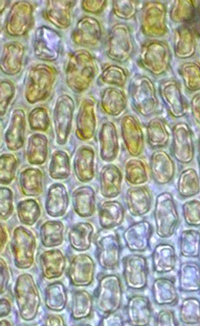
HEDWIGIACEAE
Braunia
|
Hedwigiaceae Hedwigia Pseudobraunia |
Braunia.
|
| A provisional key to the species of Braunia worldwide. | |
|
There are 23 species included in this key.
Most species of Braunia are identified unambiguously, particularly when sporophytes are available; but others are only differentiated in the key as species complexes, waiting further detailed studies. For example, the Braunia plicata species complex includes B. plicata, B. canescens Schimp ex E.Britton, and B. incana Müll.Hal. This group of species is mainly of South American distribution. Also, in the same pending situation is the B. diaphana species complex that includes B. diaphana and B. arbuscula (Welw. & Duby) A.Gepp. These two species are exclusively distributed in Africa. Similarly, the B. entodonticarpa species complex includes B. entodonticarpa and B. camptoclada P. de la Varde & Thér., these two species also of African distribution. As for the South American B. exserta species complex, already there is a key for separating B. exserta Müll.Hal., B. reflexifolia (Müll.Hal.) E.B.Bartram, and B. tucumanensis Biasuso (Biasuso, 1992). |
1a. Upper leaf cells narrow-elongate (3-5:1), cell walls very sinuous; leaf apex gradually differentiated, acuminate to subulate; leaf lamina mostly flat ............. 2
 |
Upper leaf cells narrow-elongate (a), quadrate or rectangular (b).
Leaf apex mucronate or cuspidate. |
2a. Leaf margin erect, or reflexed at base; apex long 1/3-1/2 of leaf length, subulate; leaves narrowly lanceolate, spreading; capsules urceolate …… 3
|
Leaves oblong-lanceolate.
|
3a. Leaf subula long, approaching half of leaf length ….. B. nephelogenes De Luna & Buck (Ecuador, Peru, Bolivia).
|
Leaves narrowly lanceolate, leaf apex subulate. |
4a. Leaf acumen entire, or minutely crenulate; leaf apical cells homogenously narrow elongate ................................................................................................................. 5
|
Leaf apical cells mixed broad subquadrate with elongated cells in B. subplicata |
5a. Capsule cylindrical; seta 8-14 mm; perichaetial leaves very long, more than twice the size of vegetative leaves .................... B. cirrhifolia (Mitt.) Wils. ex Jaeger (Ecuador, Peru, Bolivia).
|
B. cirrhifolia |
6a. Capsule elliptic, urn wall irregularly wrinkled, microstomus; seta long (7-15 mm); paraphyses long, exserted. ................................ B. secunda (Hook.) Bruch & Schimper (US, Mexico, Guatemala, Dominican Republic, Haiti, Venezuela, Bolivia).
|
Capsule elliptic. |
7a. Leaves slenderly lanceolate, leaf acumen short, less than 1/5 the leaf length ... B. rupestris (Mitt.) Jaeger (Cameroon, Ethiopia, Uganda, Rwanda, Tanzania).
|
B. rupestris |
8a. Leaf acumen hyaline; leaf margin at apex dentate; leaf apical cells elongated, strongly papillose ............................................................................................. 9
8b. Leaf acumen concolorous, sometimes hyaline but only at the leaf tips; leaf margin at apex entire; leaf apical cells quadrate to subquadrate .............................. 10 |
|
9a. Leaf margin recurved up to the acumen; leaf apical cells with tall papillae; perichaetial leaves narrowly lanceolate, acuminate ...... B. plicata species complex (Mexico, Peru, Bolivia, Argentina, Brasil, Paraguay).
|
Braunia plicata from Bolivia |
10a. Leaves broadly obovate to orbiculate, deeply concave to cucullate; leaf acumen mucronate to shortly cuspidate; leaf apical cells quadrate, homogeneous ................. 11
|
|
11a. Perichaetial leaves long, more than twice the length of vegetative leaves; leaves obovate, cuspidate ..................... B. entodonticarpa species complex (Kenya, Rwanda, South Africa).
|
Leaves obovate, and orbiculate. |
12a. Leaf margin broadly recurved up to the acumen .......................................... 13
|
Leaves ovate to oblong. |
13a. Seta very long (12-20 mm); capsules narrowly cylindric; leaf acumen long cuspidate .................................. B. macropelma (Müll. Hal.) Jaeger (India).
|
|
14a. Capsules totally exserted, smooth to slightly wrinkled; perichaetial leaves broadly oblong; leaves large, broadly obovate … B. subincana Broth. (Venezuela, Peru, Bolivia, Argentina, Brasil).
|
Capsules broadly ellipsoid. |
15a. Seta short (3-5 mm); capsule broad ellipsoid to urceolate, emergent; leaves broadly ovate to oblong, erect, or squarrose spreading .......... B. exserta species complex (Peru, Bolivia, Argentina, Chile).
15b. Seta long (6-10 mm); capsule cylindrical to ellipsoid, exserted; leaves ovate or ovate lanceolate, imbricate ………… 16 |
Braunia exserta from Argentina |
16a. Perichaetial leaves short, only as long as vegetative leaves; leaf apex subtubulose, margin entire ........... B. alopecura (Brid.) Limpr. (Switzerland, France, Italy, Portugal, Iran, Kwait, Saudi Arabia, China).
|
Capsules cylindrical to ellipsoid. |
17a. Capsules ellipsoid, wrinkled; exothecial cells polygonal ............. B. andrieuxii Lor. (US, Mexico, Colombia).
|
B. andrieuxii from México |